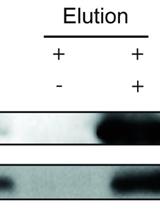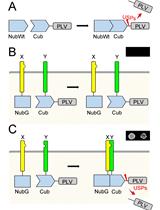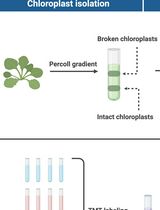- EN - English
- CN - 中文
UV Cross-linking Assay and Competition Assay
RNA与RNA结合蛋白互作研究-紫外交联联合探针竞争
发布: 2012年12月20日第2卷第24期 DOI: 10.21769/BioProtoc.310 浏览次数: 21916
Abstract
UV cross-linking assay is a standard method used to detect protein-RNA interaction. This method takes advantage of UV irradiation to trigger the formation of the covalently bonded RNP (ribonucleoprotein) complex that is more stable and makes it possible to be isolated in the denaturing conditions. Briefly, 32P-labeled RNA probe and proteins are incubated to form RNP complexes spontaneously; the mixture is then exposed to UV irradiation, followed by treatment with ribonuclease to remove RNA fragments not covalently bound to protein. The oligoribonucleotide-protein complexes are analyzed by SDS-PAGE, and the signals visualized by phosphorimaging. Competitive UV cross-linking assay is a method to determine the protein binding sites and specificity on the RNA substrate. In this assay, the excessive amounts of unlabeled competitor RNA are pre-incubated with the proteins prior to the addition of 32P-labeled RNA probe. If the competitor RNA comprises the protein binding region, the bindings between proteins and RNA probes will be competed and the radioactive binding signals will be reduced.
Keywords: UV cross-linking assay (紫外交联分析)Materials and Reagents
- Purified recombinant protein or cell extract
- RNase inhibitor (Promega Corporation, catalog number: N251B )
- BSA (Sigma-Aldrich, catalog number: A7906 )
- Yeast total RNA (Life Technologies, Ambion®, catalog number: AM9260G )
- Tween 20 (AM7118)
- RNase A (Sigma-Aldrich, catalog number: R4875 )
- RNase T1 (Epicentre Biotechnologies, catalog number: NT09100K )
- Materials for SDS-PAGE
- Transcription optimized 5x buffer (Promega Corporation, catalog number: P118B )
- Recombinant RNasin® Ribonuclease Inhibitor (20 unit) (Promega Corporation, catalog number: N251B )
- RNase-Free DNase (1 unit) (Promega Corporation, catalog number: M610A )
- [α-32P] UTP (50 μCi at 10mCi/ml) (IZOTOP)
- Illustra MicroSpin G-50 Column (GE Healthcare Life Sciences, catalog number: GE-27-5330-02 )
- T7 RNA Polymerase (20 unit) (Promega Corporation, catalog number: P207B )
- DTT (Promega Corporation, catalog number: P117B )
- Bromphenol blue
- β-Mercaptoethanol
- 32P-labeled RNA probe (see Recipes)
- 4x binding buffer (see Recipes)
- 5x protein sample buffer (see Recipes)
- Competitor RNA transcripts (see Recipes)
Equipment
- 37 °C and 100 °C water baths
- 254-nm UV light source (Stratagene, UV stratalikerTM, model: 1800 )
- Equipments for SDS-PAGE
- Gel Dryer (Bio-Rad Laboratories, model: 583 )
- Imaging plate (Fujifilm Corporation)
- Fujifilm BAS-1500 Image Analyzer (Fujifilm Corporation, Multi Gauge)
Procedure
文章信息
版权信息
© 2012 The Authors; exclusive licensee Bio-protocol LLC.
如何引用
Readers should cite both the Bio-protocol article and the original research article where this protocol was used:
- Huang, Y. and Hsu, Y. (2012). UV Cross-linking Assay and Competition Assay. Bio-protocol 2(24): e310. DOI: 10.21769/BioProtoc.310.
- Huang, Y. W., Hu, C. C., Liou, M. R., Chang, B. Y., Tsai, C. H., Meng, M., Lin, N. S. and Hsu, Y. H. (2012). Hsp90 interacts specifically with viral RNA and differentially regulates replication initiation of Bamboo mosaic virus and associated satellite RNA. PLoS Pathog 8(5): e1002726.
分类
生物化学 > RNA > RNA-蛋白质相互作用
植物科学 > 植物生物化学 > 蛋白质 > 相互作用
您对这篇实验方法有问题吗?
在此处发布您的问题,我们将邀请本文作者来回答。同时,我们会将您的问题发布到Bio-protocol Exchange,以便寻求社区成员的帮助。
Share
Bluesky
X
Copy link













